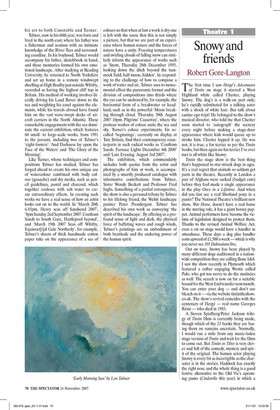Elemental forces
Angela Summerfield Len Tabner Messum's, 8 Cork Street, London Wl, until 1 December For those of us who live in the British Isles there are two unassailable facts. We are island dwellers who live surrounded by turbulent seas. Our emotional lives, in other words how we experience our existence and express ourselves, often have recourse to rich literary and visual traditions centred on two subjects: the land and the sea. The progenitors of a visual sensibility were Constable and Turner. Both artists pushed the boundaries in terms of how art materials could be handled, and how subject matter, such as farmland, mountains, beaches and the sea, and the intrinsic four elements (air, light, water and earth), could be interpreted as an expression of sentiment and awe. How we could experience these subjects today lies at the very heart of Len Tabner's paintings, and it is not surprising that cultural commentators have compared his art to both Constable and Turner.
Tabner, now in his 60th year, was born and bred in the north-east, where his father was a fisherman and seaman with an intimate knowledge of the River Tees and surrounding coastline. In his boyhood, Tabner would accompany his father, sketchbook in hand, and these memories formed his own emotional landscape. After studying at Reading University, he returned to North Yorkshire and set up home in a remote windswept dwelling at High Boulby just outside Whitby, recorded as having the highest cliff top in Britain. His method of working involves literally driving his Land Rover down to the sea and weighting his easel against the elements, while his travels abroad have found him on the vast wave-swept decks of aircraft carriers in the North Atlantic. These remarkable engagements with the sea dominate the current exhibition, which features 60 smallto large-scale works, from 1991 to the present, including two of Tabner's 'eight-footers': 'And Darkness lay upon the Face of the Waters' and 'The Glory of the Morning'.
Like Turner, whose techniques and compositions Tabner has studied, Tabner has forged ahead to create his own unique use of watercolour combined with body colour (gouache) and dry media, such as pencil guidelines, pastel and charcoal, which together coalesce with salt water to create extraordinary effects. In creating such works we have a real sense of how an artist looks out on to the world. In 'March 20th 6.45pm. Heavy seas off Sandsend 2007', `8pm Sunday 2nd September 2007. Coatham Sands to South Gare, Hartlepool beyond', and 'March 19th 2007 Seas off Whitby, Equinoct[ilal Gale Northerly', for example, Tabner's sheets of thick handmade cotton paper take on the appearance of a sea of colours so that when at last a work is dry one is left with the sense that this is not simply a picture, but that we are part of an experience where human nature and the forces of nature have a unity. Freezing temperatures and swirling clouds of falling snow can similarly inform the appearance of works such as 'Snow, Thursday 28th December 1995, looking down the ditch beyond the tummock field, half moon, hidden'. In responding to the challenge of how to compose a work of water and air, Tabner uses to monumental effect the panoramic format and the division of compositions into thirds where the eye can be anchored by, for example, the horizontal form of a breakwater or headland, such as in the powerful 'Moon breaking through cloud. Thursday 30th August 2007 10pm. Pilgrims' Causeway', where the protean washes of colour unite the sea and sky. Turner's colour experiments, his socalled 'beginnings', currently on display at Tate Britain, find their contemporary counterparts in such radical works as `Coatham Sands. Furnace Lights December 4th 2000' and 'Late Evening. August 3rd 2007'.
The exhibition, which commendably includes both quotes from the artist and photographs of him at work, is accompanied by a smartly produced catalogue with informative contributions from Tabner, Sister Wendy Beckett and Professor Fred Inglis. Something of a partial retrospective, the show is also a personal tribute by Tabner to his lifelong friend, the Welsh landscape painter Peter Prendergast. Tabner has described his own work as conveying 'the spirit of the landscape'. By offering us a profound sense of light and dark, the physical force of buffeting waves and rough winds, Tabner's paintings are an embodiment of both beatitude and the enduring power of the human spirit.







































































 Previous page
Previous page